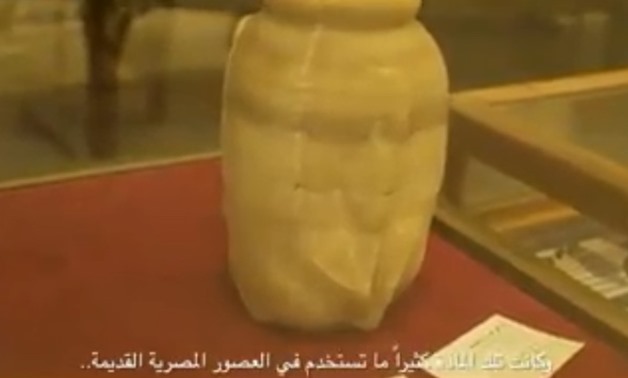
File- vase in the shape of a Trussed Goose.
CAIRO - 17 April 2020: Ministry of Tourism and Antiquities organised a guided video tours for vase in the shape of a Trussed Goose on April 16.
The vase was discovered in 1935 in one of the underground galleries beneath the Step Pyramid of King Djoser in Saqqara.
This curious 65-centimetre tall alabaster vase is shaped like a trussed goose with its feathers plucked.
Its wings and legs can be clearly seen on the its sides, whereas its curled neck and head creatively form its rim.
The shape of the vase suggests that it may have been used to store goose oil, or perhaps even dried up goose for consumption in the afterlife.
It is one of many stone vases and fragments of vases discovered in the Step Pyramid’s substructure.
Many of these were discovered in the same and in other galleries as the trussed goose vase bear names of kings. Interestingly, even though Djoser was a king of the Third Dynasty, these are the names of kings from the preceding Second Dynasty (c.2890–2686 BC).
It is believed that Djoser wished to keep his predecessors’ possessions safe by collecting them and storing them in his house for eternity—his tomb. In doing so, he thus forever associated himself with his ancestors.
On April 15, the Ministry of Tourism and Antiquities launched a guided video tour for Narmer Palette at the Egyptian Museum in Tahrir Square.
It is made of green schist and it is 64 cm high and 42 cm wide. It was discovered in the remains of an Old Kingdom temple complex in Hierakonpolis (modern Kom al-Ahmar) near Edfu, and dates to the beginning of the First Dynasty (c.3100 BC)—to the dawn of Egyptian civilization.
Although this object is, in form, a cosmetic palette, it was ceremonial, and was never actually used for cosmetics.
In the center of the front side, two fierce feline fantastic animals with long necks are being brought under control, symbolizing a recent historical event of the utmost significance that had recently taken place: the unification of Upper and Lower Egypt into the world’s oldest nation state—Egypt.
In the top register, the king, wearing the Red Crown of Lower Egypt, is marching in a victory procession, while before him lie his beheaded enemies.
In the lower register, the king, as a bull, is destroying a walled city. On the back side of the palette the king, wearing the White Crown of Upper Egypt, is about to smite a Lower Egyptian enemy chief with a mace while, before him, his ancestor, the god Horus, dominates a personification of the land of Lower Egypt.

Comments
Leave a Comment